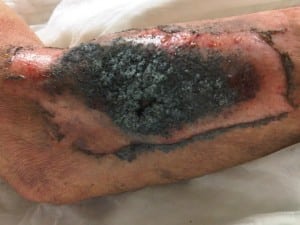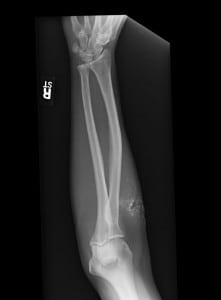| Author | Affiliation |
|---|---|
| Joseph McCarthy, DO | Lakeland Regional Medical Center, Department of Emergency Medicine, St Joseph, Michigan |
| Christopher Trigger, MD | Lakeland Regional Medical Center, Department of Emergency Medicine, St Joseph, Michigan |
INTRODUCTION
A previously healthy 65-year-old male presented to the emergency department complaining of a burn to his right forearm. Just prior to arrival the patient was working at a tool and die company casting products with molten aluminum where he inadvertently caused his injury. Physical examination revealed a burn to the right forearm of varying degrees of severity. A non-painful charred central area was observed with surrounding erythema and swelling (Figure 1). Patient had full motor strength of his wrist and elbow. He also had normal neuro-vascular status distal to the injury. A radiograph was performed to assess the depth of the injury (Figure 2).
Figure 1. Right forearm with 2nd, 3rd, and 4th degree burns.
Figure 2. Right forearm radiograph showing radiopaque material in the subcutaneous tissues.
DISCUSSION
High-pressure injection injury with molten aluminum
High-pressure injection injuries typically look benign with a small site of entry, often initially painless and numb, but can quickly become painful with severe swelling that can lead to compartment syndrome and gangrene.1 Commonly injected materials include paint, grease, and hydraulic fluid with the risk of amputation being greater than 40%.2 Due to the serious nature of all high-pressure injections, urgent surgical consultation with likely debridement is required.
Similarly, molten metal thermal burns are often small in gross appearance, at least when compared to other thermal burns. On average, 2.3% of mean body surface is involved in the burn, but typically full thickness.3 The severity of molten metal thermal burns can easily be overlooked and the delay in proper treatment often leads to extended hospital stays and increased length of time to return to work when compared to earlier referral to a surgeon.3
Whether a high-pressure injection injury, molten metal thermal burn, or combination of both, urgent consultation to a surgeon is warranted. The patient will likely require irrigation and debridement in the operating room with possible amputation depending on the severity. The patient in this case underwent debridement and split-thickness skin grafting by a plastic surgeon that specializes in burn reconstruction. Patient had no loss of function of his affected arm and had a full recovery.
Footnotes
Address for Correspondence: Joseph McCarthy, DO, Lakeland Regional Medical Center, Department of Emergency Medicine, 1234 Napier Avenue, St. Joseph, MI 49085. Email: jmccarthy@lakelandregional.org. 3 / 2014; 15:120 – 121
Submission history: Revision received September 12, 2013; Submitted October 5, 2013; Accepted October 28, 2013
Conflicts of Interest: By the WestJEM article submission agreement, all authors are required to disclose all affiliations, funding sources and financial or management relationships that could be perceived as potential sources of bias. The authors disclosed none.
REFERENCES
1. Mirzayan R, Holtom PD, Schnall SB, et al. Culture results and amputation rates in high-pressure paint gun injuries of the hand. Orthopedics. 2001;24:587-589.
2. Hogan CJ, Ruland RT. High-pressure injection injuries to the upper extremity: A review of the literature. J Orthop Trauma. 2006;20:503-511.
3. Margulies DR, Navarro RA, Kahn AM. Molten metal burns: Early treatment improves outcome. Am Surg. 1998;64(10):947-949.




